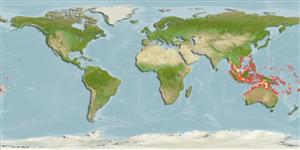>
Ovalentaria/misc (Various families in series Ovalentaria) >
Pomacentridae (Damselfishes) > Pomacentrinae
Etymology: Amblyglyphidodon: Greek, amblys = darkness + Greek, glyphis = carved + Greek, odous = teeth (Ref. 45335).
More on author: Bloch.
Environment: milieu / climate zone / depth range / distribution range
Sinh thái học
Biển Cùng sống ở rạn san hô; không di cư; Mức độ sâu 1 - 40 m (Ref. 1602), usually 1 - 15 m (Ref. 90102). Tropical; 25°N - 30°S, 94°E - 167°W
Western Pacific: Rowley Shoals (eastern Indian Ocean) and Malaysia to Samoa and Tonga (Ref. 53797), north to the Ryukyu Islands, south to the Great Barrier Reef.
Bộ gần gũi / Khối lượng (Trọng lượng) / Age
Maturity: Lm ? range ? - ? cm
Max length : 11.0 cm TL con đực/không giới tính; (Ref. 48636)
Các tia vây lưng cứng (tổng cộng) : 13; Các vây lưng mềm (tổng cộng) : 12 - 13; Tia cứng vây hậu môn: 2; Tia mềm vây hậu môn: 13 - 15.
Adults inhabit lagoons, coastal embayments, reef passages and outer reefs. Juveniles often found among Sarcophyton and Sinularia soft corals. Feeding aggregations are frequently observed over growths of the staghorn coral Acropora. Feed on zooplankton and filamentous algae (Ref.1602). The stomach contents of a specimen included larval crabs and shrimps, fish eggs, and algae. Oviparous, distinct pairing during breeding (Ref. 205). Dead coral branches serve as nests (Ref. 90102). Eggs are demersal and adhere to the substrate (Ref. 205). Males guard and aerate the eggs (Ref. 205).
Life cycle and mating behavior
Maturities | Sự tái sinh sản | Spawnings | Egg(s) | Fecundities | Ấu trùng
Oviparous, distinct pairing during breeding (Ref. 205). Eggs are demersal and adhere to the substrate (Ref. 205). Males guard and aerate the eggs (Ref. 205).
Allen, G.R., 1991. Damselfishes of the world. Mergus Publishers, Melle, Germany. 271 p. (Ref. 7247)
IUCN Red List Status (Ref. 130435)
Threat to humans
Harmless
Human uses
Các nghề cá: không ích lợi (thú vị); Bể nuôi cá: Tính thương mại
Các công cụ
Special reports
Download XML
Các nguồn internet
Estimates based on models
Preferred temperature (Ref.
123201): 24.7 - 29, mean 27.9 °C (based on 628 cells).
Phylogenetic diversity index (Ref.
82804): PD
50 = 0.5005 [Uniqueness, from 0.5 = low to 2.0 = high].
Bayesian length-weight: a=0.02951 (0.01912 - 0.04556), b=3.00 (2.87 - 3.13), in cm total length, based on LWR estimates for this species & (Sub)family-body (Ref.
93245).
Mức dinh dưỡng (Ref.
69278): 2.6 ±0.1 se; based on diet studies.
Thích nghi nhanh (Ref.
120179): Chiêù cao, thời gian nhân đôi của chủng quần tối thiểu là dưới 15 tháng (Preliminary K or Fecundity.).
Fishing Vulnerability (Ref.
59153): Low vulnerability (10 of 100).
Nutrients (Ref.
124155): Calcium = 109 [54, 183] mg/100g; Iron = 0.883 [0.518, 1.503] mg/100g; Protein = 17.9 [16.7, 19.1] %; Omega3 = 0.114 [0.064, 0.196] g/100g; Selenium = 25.9 [12.4, 54.4] μg/100g; VitaminA = 130 [34, 493] μg/100g; Zinc = 1.69 [1.11, 2.53] mg/100g (wet weight);
